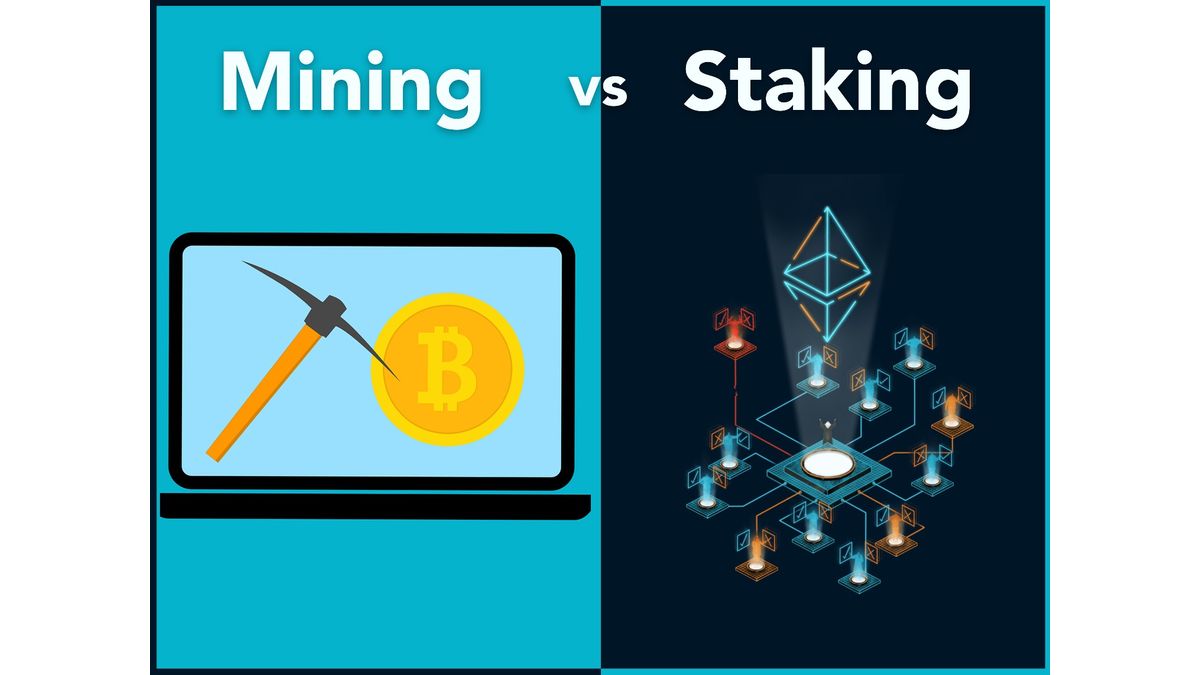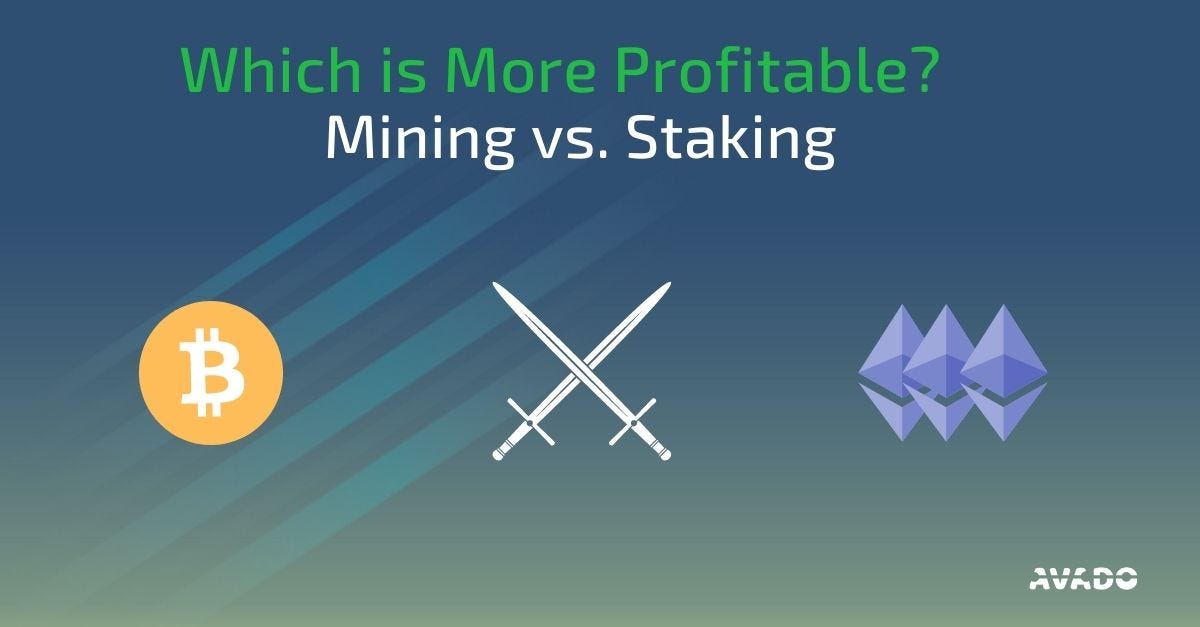
July 20, 2021
Staking Ethereum vs. Mining Bitcoin — Which is More Profitable?
Staking Ethereum vs. Mining Bitcoin - Which is More Profitable?
Jun 21 · 7 min read

The most popular currencies, Ethereum and Bitcoin, are making ways for investors to earn more. Considering the swift pace of cryptocurrency acquisition, it is estimated by researchers and analysts that the cryptocurrency market will strike a figure of USD 1,758.0 million by 2027. Through contributing to the network, some blockchain protocols qualify participants to receive additional cryptocurrency. Staking, mining, and other methods are also used to obtain these rewards.
Staking ETH and mining BTC are the two most profitable ways for investors to earn more income. By calculating the cost vs. rewards in this article we discuss which method is more profitable.
What is Ethereum Staking?
The blockchain of the Ethereum network is being upgraded. The network can only process about 15 transactions per second due to Ethereum’s proof of work architecture. Ethereum’s blockchain would benefit from the Eth 2.0 update in terms of spend and transaction throughput.
This Ethereum update replaces crypto miners with Ethereum validators, a Proof of Stake (POS) model. Anyone who owns Ether tokens can become a validator and earn awards in the process. The interest rate counterpart of these incentives is currently approximately 7.5% per year.
How to do it?
To become a validator, it is required to run your own Ethereum node with a minimum stake of 32 ETH. When you deposit 32 ETH, you can activate a validator software. The validator is responsible for validating blockchain transactions and managing blocks that will lead to the secure Ethereum; in this process, validators earn ETH as a reward.
These are the primary sites currently offering stakeouts like Kraken, Coinbase, Gemini, and other staking pools.
Estimated Profitability
The price of 1 ETH is 2,887.61$ at the point of writing this article, and a validator can start from 32 ETH, which will cost 88,765.44$. Early on the Eth 2.0 user was able to earn rewards up to 22.7% APR, which was the highest annual rate. However, APR decreases when more validators join the network. Right now, you can earn between 6% to 7.5% APR as a reward on any Ethereum that you stake. Other than that, stake ETH earnings depend upon how much Ethereum is validating and how many rewards the network is offering at that specific period.
Collin Myers, head of global product strategy of ConsenSys at the launch of the Ethereum 2.0 network, said that “validators with 32 ETH can expect to earn up to 4.6 to 10.3% in annualized returns.”
On average, investors in Ethereum, can expect to earn around $29.17 in a day from staking.
Pros and cons
The advantages of staking Ethereum are that becoming a validator is much easier and it doesn’t require much effort. PoS networks consume much less energy than the PoW networks, therefore it is also less expensive to be an Ethereum 2.0 validator.
Another advantage of staking Eth2 is that you get a return on your primary investment. As previously described, the rewards are expected to stabilize around 4% to 8% each year.
The main disadvantage is that if Ethereum tokens lose value, you cannot sell them because Eth 2.0 has not yet been released. You cannot unstake Eth 2.0 right now because converting Eth to Eth2.0 is only possible one way. Your earnings are locked up for a while.
Ethereum can only be used by investors who see it as a long-term investment. When the Ethereum 2.0 project is launched, your Ether2.0 tokens will be more liquid.
What is Bitcoin Mining?
Bitcoin mining is a process of solving complex computing puzzles. A miner has to solve highly complicated computer math problems and difficult puzzles, and in return, miners earn a new bitcoin.
Mining cryptocurrency is time-consuming, costly, and just sometimes lucrative. On the other hand, mining has a magnetic appeal for many cryptocurrency investors, as miners are paid for their efforts with crypto tokens. This may be because, like the California gold miners of 1849, entrepreneurs view mining as a gift from above. Why not do this if you are tech-savvy?
Before you invest your time and resources in the mining, read this guide to see if it’s right for you.
How to do it?
Miners in the bitcoin network are in the race of solving complicated computing puzzles. To solve the puzzle, miners had to do thousands of calculations in seconds, called the hash rate. If a miner gets the correct answer, they are rewarded with a new BTC. The higher the hash rate, the more puzzles it will solve, and the more bitcoins miners will be able to win.
Miners are eligible for payment with bitcoin after validating 1MB (megabyte) of bitcoin transactions, known as a “block.” However, not everyone who verifies the transactions gets paid. To earn BTC, you must have to verify approximately 1MB of transactions, and you must be the first miner to solve a number problem with the correct or closest answer. Proof of work is another name for this procedure.
1MB of transactions can potentially be as small as one (although this is very rare) or several thousand. It depends on how much data the transactions consume.
Estimated Profitability
Every four years, the payouts for bitcoin mining are divided. When bitcoin was first mined in 2009, each block was worth 50 bitcoins. It was reduced to 25 BTC in 2012. By 2016, it had been reduced to 12.5 BTC once more. The reward was reduced to 6.25 BTC on May 11, 2020. The price of Bitcoin is about $35,000 per Bitcoin in June 2021, which means that completing a block would earn you $210,00 (6.25 x 35,000). It does not seem to be a poor reason to solve the above-mentioned complex hash problem.
Let’s take an example if the bitcoin hash rate is 85 ETH/s (85,000,000 TH/s); miner hash rate 68 TH/s, number of blocks per day 144, block reward would be 6.25. Then you will earn 0.000702 BTC/day before pool fees. And now the question is how it is calculated?
So the formula is;
Miner hash rate/ hash rate * number of block per day * block reward
68 / 85,000,000 * 144 * 6.25 = 0.000702 BTC/day. In fiat value, as of today’s bitcoin price, it amounts to $24.7/day.
The cost of mining gadgets is not cheap at all. The mining device DragonMint T 1 came up with the best hardware Antminer device, costing around $2,700 to $3,000 . As it requires huge powerful computing systems, the power supply is sold separately, which costs another $100 to $150. It consumes 72,000 GW (or 72 Terawatts) of electricity.
On the other hand, the maintenance of these devices is complicated. You have to check the devices frequently; if it’s burning, then give the device a rest. To run the machines requires a considerable place. The hidden fact is that miners also require a pool supporting ASICBoost, which cost approximately $25.
Pros and Cons
There is no advanced math or calculation needed. Miners seem to solve complex mathematical problems, but this is not the case. They’re attempting to be the first miner to generate a 64-digit hexadecimal number (a “hash”) that is either less than or equal to the aim hash. It’s essentially a game of guessing.
It’s guesswork, but it’s excruciatingly challenging because the total number of possible guesses on each question is in the trillions. To solve a problem, miners need a lot of computing resources. You’ll need a high “hash rate” to mine successfully, which is calculated in mega hashes per second (MH/s), Giga hashes per second (GH/s), and tera hashes per second (TH/s).
The advantage is that miners do not need to invest a penny. Without investing, miners can earn bitcoin as a reward. Despite solving all by yourself, to decrease the chance of risk, you can also enter a pool to improve winning Bitcoin. To maximize the benefits of solving a block, all miners in a single pool combine their hash power. The sum of the payout will be divided according to the hash rate you added to the pool after it has been submitted. Rather than that, you can also do it all by yourself, the task is risky, but the reward will be worth it.
Recommendation
Staking Ethereum is an ideal way to maximize your return on investment, whether the value of Ethereum remains stable or increases. Rather than just owning the assets, you can earn Ethereum-based interest and collect more cryptocurrency. On the other hand, mining bitcoin is quite risky. It is hard to solve the puzzle alone; if a miner does it, it is fruitful. If not, then miners have to join a pool where the reward will be divided by the number of miners who are part of the pool.
It is hard for the non-tech savvy to make investments on crypto platforms as it is complicated and requires too many energy-consuming massive computing systems. Staking ETH with AVADO devices is a suitable solution for non-tech investors. AVADO is a plug-and-play solution as it requires less energy, is easy to understand, and easy to use. You can stake not only Eth2.0 but other tokens at home and earn passive income. Discover how AVADO works here.
